RENAULT MEGANE 2005 X84 / 2.G Owners Manual
Manufacturer: RENAULT, Model Year: 2005, Model line: MEGANE, Model: RENAULT MEGANE 2005 X84 / 2.GPages: 250, PDF Size: 5.72 MB
Page 191 of 250
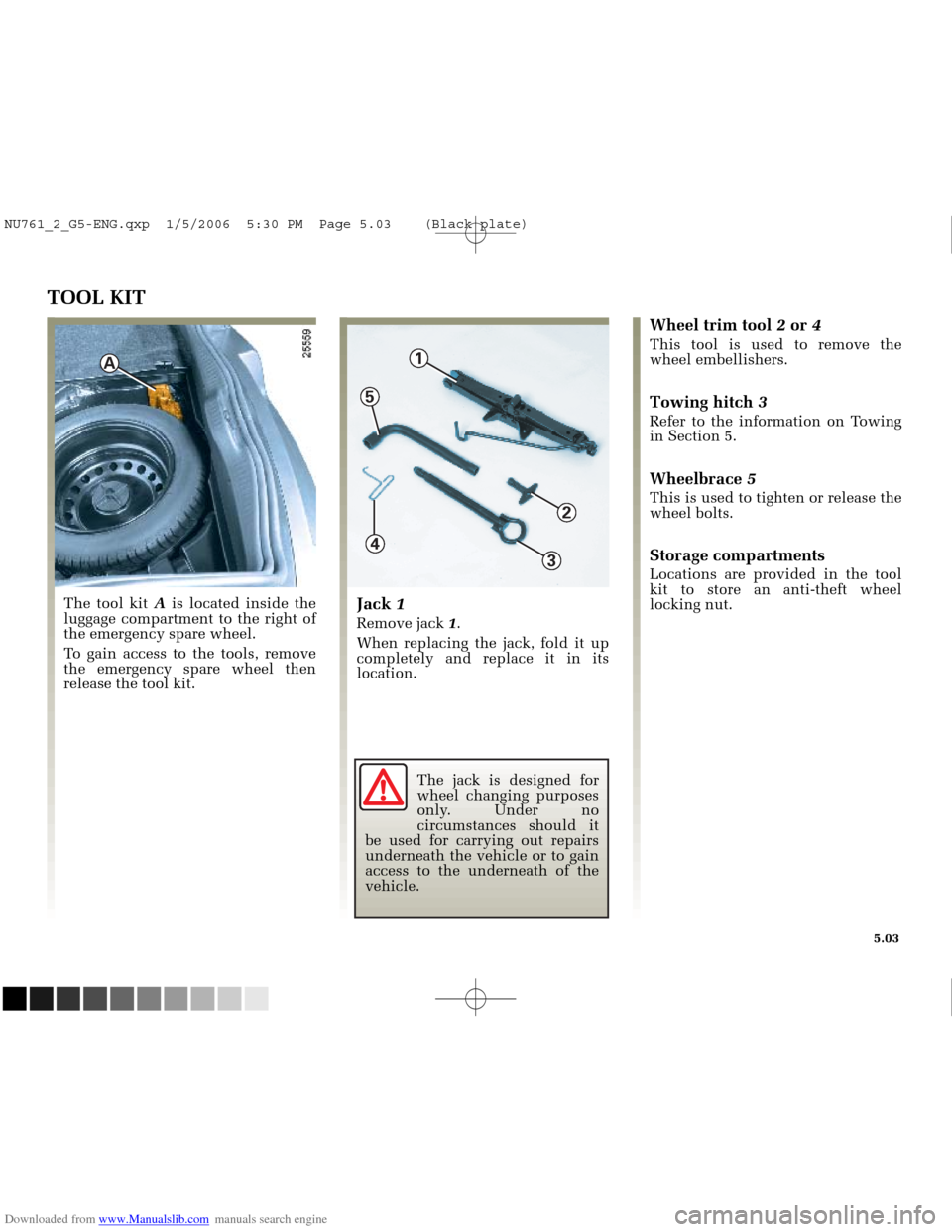
Downloaded from www.Manualslib.com manuals search engine
1
3
4
2
5
A
NU761_2_G5-FRA.qxd 4/11/05 11:09 Page 5.03
5.03
TOOL KIT
The tool kit Ais located inside the
luggage compartment to the right of
the emergency spare wheel.
To gain access to the tools, remove
the emergency spare wheel then
release the tool kit.
Wheel trim tool 2or 4
This tool is used to remove the
wheel embellishers.
Towing hitch 3
Refer to the information on Towing
in Section 5.
Wheelbrace 5
This is used to tighten or release the
wheel bolts.
Storage compartments
Locations are provided in the tool
kit to store an anti-theft wheel
locking nut.
Jack 1
Remove jack 1.
When replacing the jack, fold it up
completely and replace it in its
location.
The jack is designed for
wheel changing purposes
only. Under no
circumstances should it
be used for carrying out repairs
underneath the vehicle or to gain
access to the underneath of the
vehicle.
NU761_2_G5-ENG.qxp 1/5/2006 5:30 PM Page 5.03 (Black plate)
Page 192 of 250
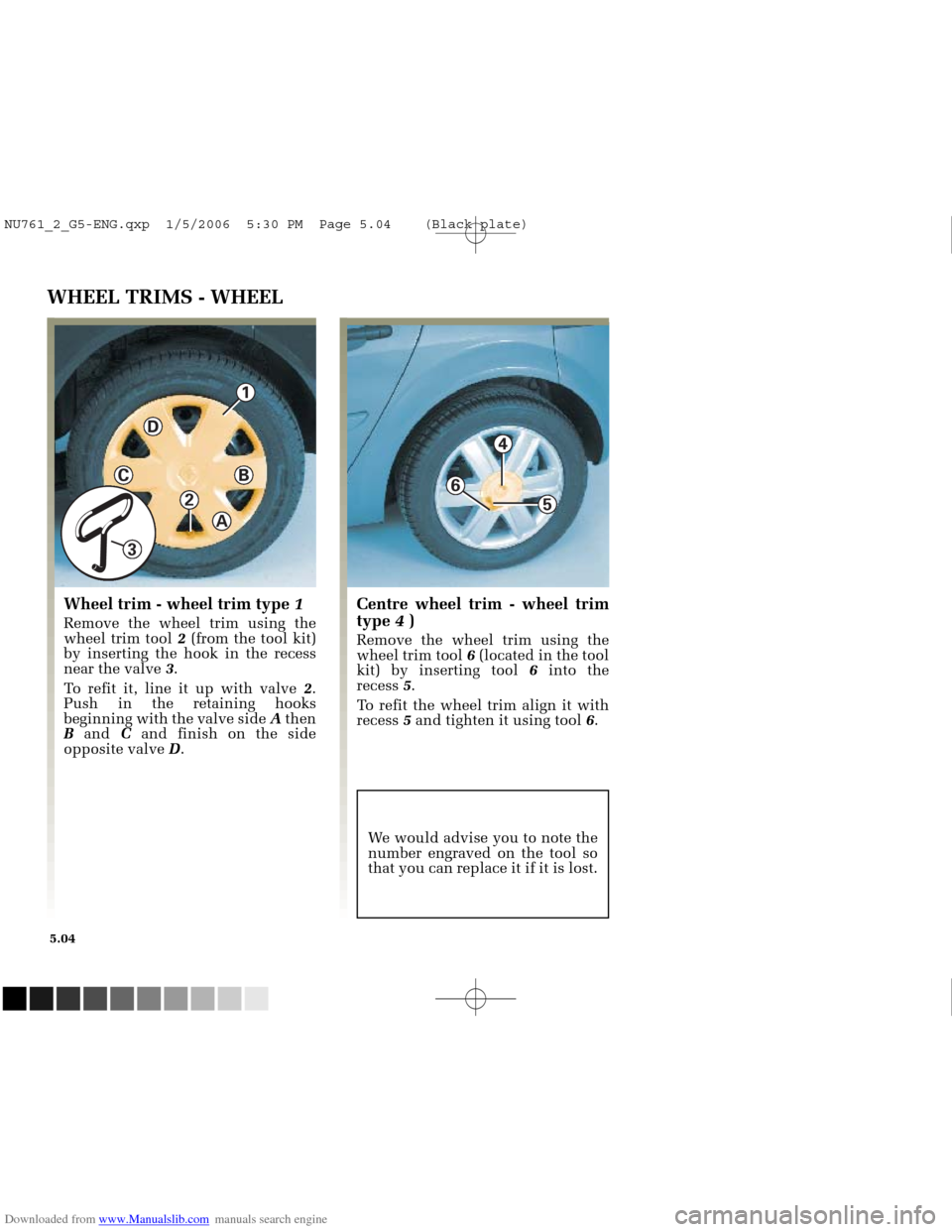
Downloaded from www.Manualslib.com manuals search engine
3
2
C
6
4
5
D
B
1
A
NU761_2_G5-FRA.qxd 4/11/05 11:09 Page 5.04
5.04
WHEEL TRIMS - WHEEL
Wheel trim - wheel trim type 1
Remove the wheel trim using the
wheel trim tool 2(from the tool kit)
by inserting the hook in the recess
near the valve 3.
To refit it, line it up with valve 2.
Push in the retaining hooks
beginning with the valve side A then
B and C and finish on the side
opposite valve D.
Centre wheel trim - wheel trim
type 4)
Remove the wheel trim using the
wheel trim tool 6(located in the tool
kit) by inserting tool 6into the
recess 5.
To refit the wheel trim align it with
recess 5and tighten it using tool 6.
We would advise you to note the
number engraved on the tool so
that you can replace it if it is lost.
NU761_2_G5-ENG.qxp 1/5/2006 5:30 PM Page 5.04 (Black plate)
Page 193 of 250
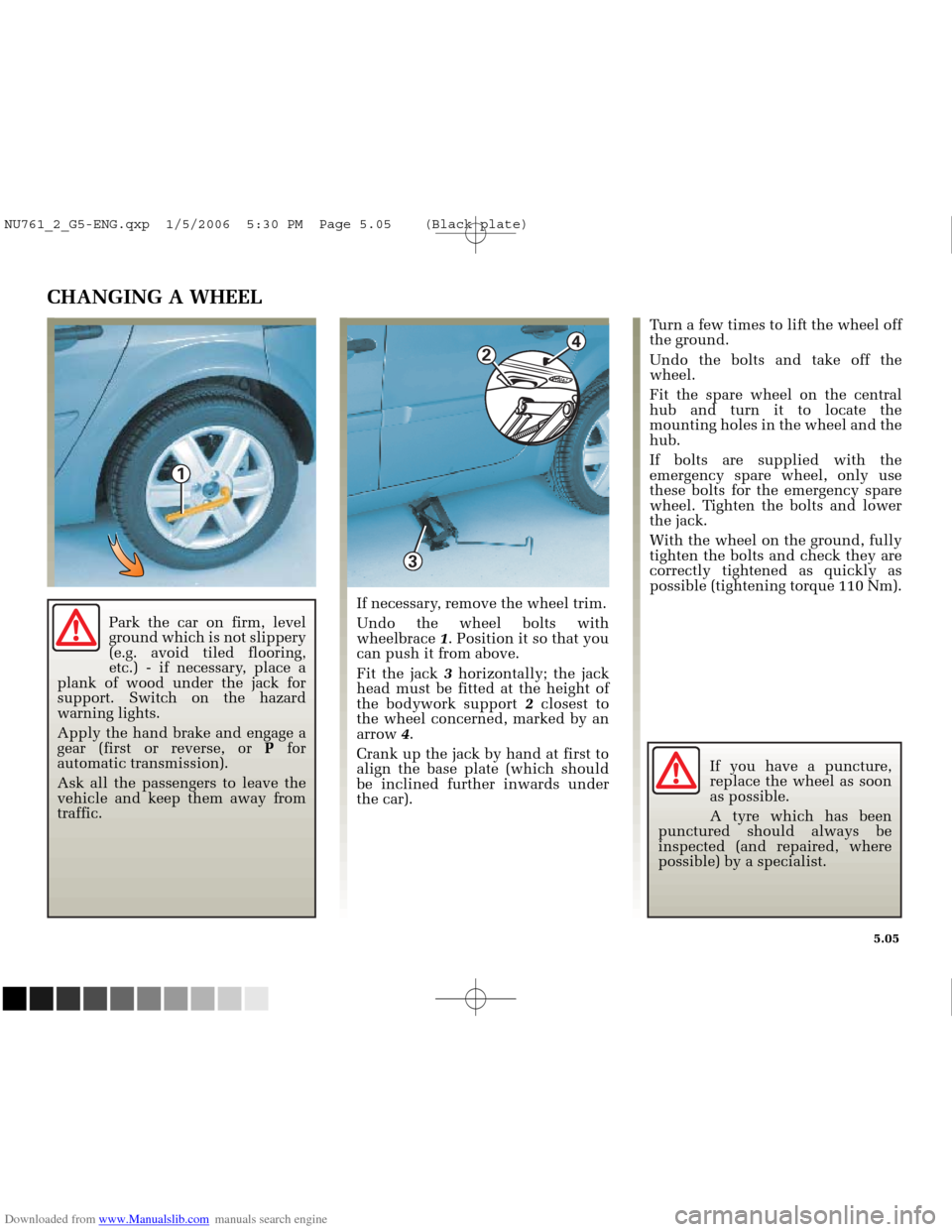
Downloaded from www.Manualslib.com manuals search engine
3
4
2
1
NU761_2_G5-FRA.qxd 4/11/05 11:09 Page 5.05
5.05
CHANGING A WHEEL
If necessary, remove the wheel trim.
Undo the wheel bolts with
wheelbrace 1. Position it so that you
can push it from above.
Fit the jack 3horizontally; the jack
head must be fitted at the height of
the bodywork support 2closest to
the wheel concerned, marked by an
arrow 4.
Crank up the jack by hand at first to
align the base plate (which should
be inclined further inwards under
the car). Turn a few times to lift the wheel off
the ground.
Undo the bolts and take off the
wheel.
Fit the spare wheel on the central
hub and turn it to locate the
mounting holes in the wheel and the
hub.
If bolts are supplied with the
emergency spare wheel, only use
these bolts for the emergency spare
wheel. Tighten the bolts and lower
the jack.
With the wheel on the ground, fully
tighten the bolts and check they are
correctly tightened as quickly as
possible (tightening torque 110 Nm).
If you have a puncture,
replace the wheel as soon
as possible.
A tyre which has been
punctured should always be
inspected (and repaired, where
possible) by a specialist.
Park the car on firm, level
ground which is not slippery
(e.g. avoid tiled flooring,
etc.) - if necessary, place a
plank of wood under the jack for
support. Switch on the hazard
warning lights.
Apply the hand brake and engage a
gear (first or reverse, or Pfor
automatic transmission).
Ask all the passengers to leave the
vehicle and keep them away from
traffic.
NU761_2_G5-ENG.qxp 1/5/2006 5:30 PM Page 5.05 (Black plate)
Page 194 of 250
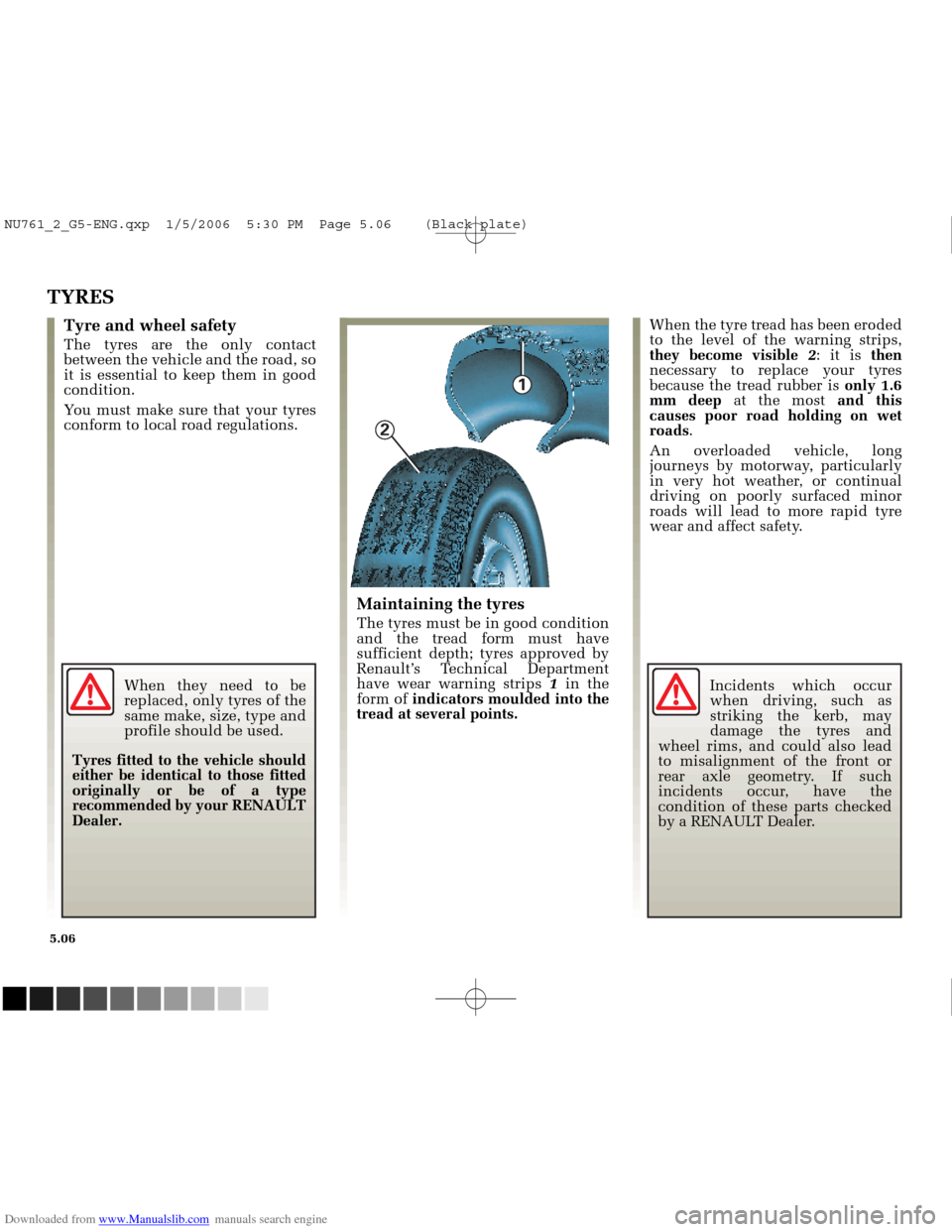
Downloaded from www.Manualslib.com manuals search engine
1
2
NU761_2_G5-FRA.qxd 4/11/05 11:09 Page 5.06
5.06
TYRES
Maintaining the tyres
The tyres must be in good condition
and the tread form must have
sufficient depth; tyres approved by
Renault’s Technical Department
have wear warning strips 1in the
form of indicators moulded into the
tread at several points.
Tyre and wheel safety
The tyres are the only contact
between the vehicle and the road, so
it is essential to keep them in good
condition.
You must make sure that your tyres
conform to local road regulations. When the tyre tread has been eroded
to the level of the warning strips,
they become visible
2: it is then
necessary to replace your tyres
because the tread rubber is only 1.6
mm deep at the most and this
causes poor road holding on wet
roads .
An overloaded vehicle, long
journeys by motorway, particularly
in very hot weather, or continual
driving on poorly surfaced minor
roads will lead to more rapid tyre
wear and affect safety.
When they need to be
replaced, only tyres of the
same make, size, type and
profile should be used.
Tyres fitted to the vehicle should
either be identical to those fitted
originally or be of a type
recommended by your RENAULT
Dealer. Incidents which occur
when driving, such as
striking the kerb, may
damage the tyres and
wheel rims, and could also lead
to misalignment of the front or
rear axle geometry. If such
incidents occur, have the
condition of these parts checked
by a RENAULT Dealer.
NU761_2_G5-ENG.qxp 1/5/2006 5:30 PM Page 5.06 (Black plate)
Page 195 of 250
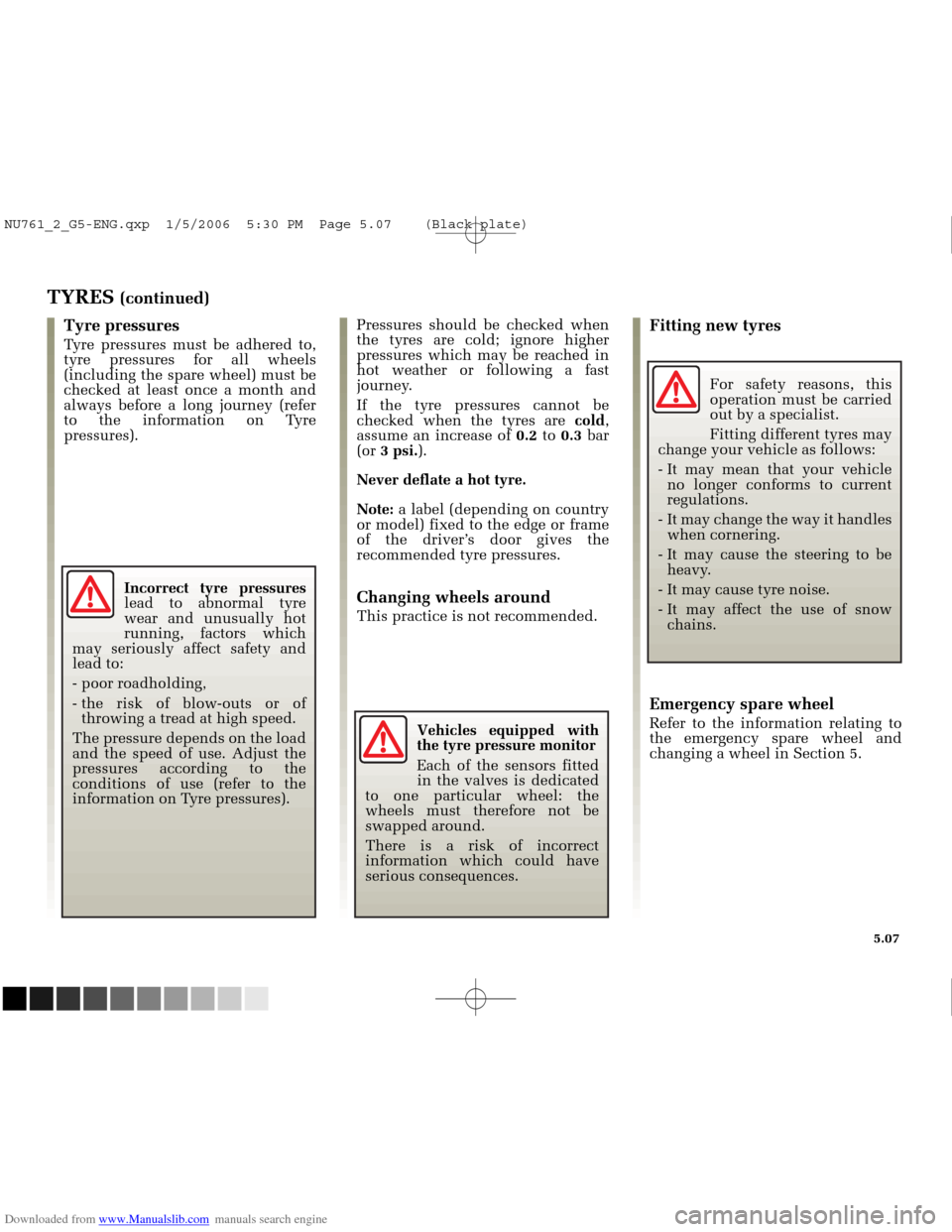
Downloaded from www.Manualslib.com manuals search engine
NU761_2_G5-FRA.qxd 4/11/05 11:09 Page 5.07
5.07
TYRES (continued)
Pressures should be checked when
the tyres are cold; ignore higher
pressures which may be reached in
hot weather or following a fast
journey.
If the tyre pressures cannot be
checked when the tyres are cold,
assume an increase of 0.2 to 0.3 bar
(or 3 psi. ).
Never deflate a hot tyre.
Note: a label (depending on country
or model) fixed to the edge or frame
of the driver’s door gives the
recommended tyre pressures.
Changing wheels around
This practice is not recommended.
Tyre pressures
Tyre pressures must be adhered to,
tyre pressures for all wheels
(including the spare wheel) must be
checked at least once a month and
always before a long journey (refer
to the information on Tyre
pressures).
Emergency spare wheel
Refer to the information relating to
the emergency spare wheel and
changing a wheel in Section 5.
Fitting new tyres
Incorrect tyre pressures
lead to abnormal tyre
wear and unusually hot
running, factors which
may seriously affect safety and
lead to:
- poor roadholding,
- the risk of blow-outs or of throwing a tread at high speed.
The pressure depends on the load
and the speed of use. Adjust the
pressures according to the
conditions of use (refer to the
information on Tyre pressures). Vehicles equipped with
the tyre pressure monitor
Each of the sensors fitted
in the valves is dedicated
to one particular wheel: the
wheels must therefore not be
swapped around.
There is a risk of incorrect
information which could have
serious consequences. For safety reasons, this
operation must be carried
out by a specialist.
Fitting different tyres may
change your vehicle as follows:
- It may mean that your vehicle no longer conforms to current
regulations.
- It may change the way it handles when cornering.
- It may cause the steering to be heavy.
- It may cause tyre noise.
- It may affect the use of snow chains.
NU761_2_G5-ENG.qxp 1/5/2006 5:30 PM Page 5.07 (Black plate)
Page 196 of 250
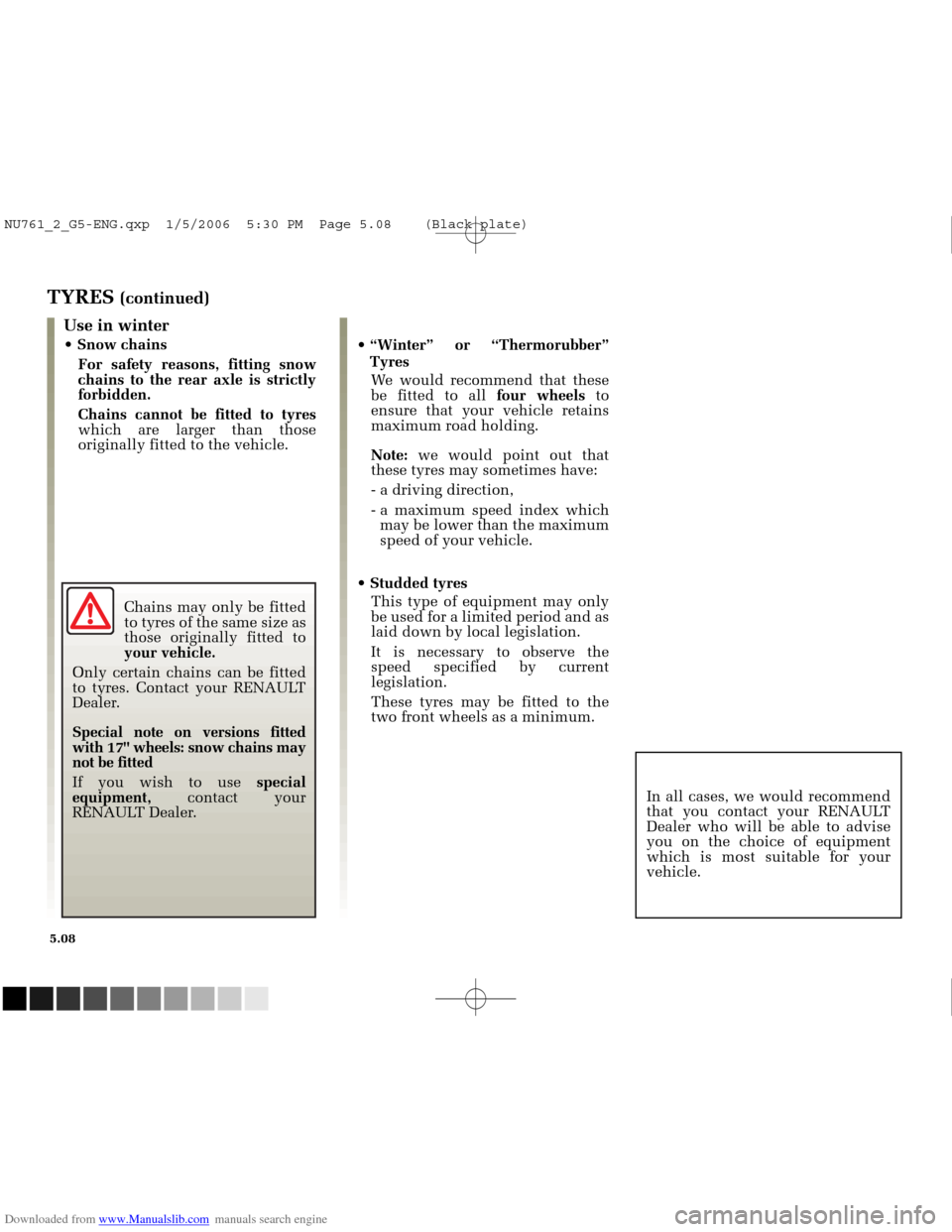
Downloaded from www.Manualslib.com manuals search engine
NU761_2_G5-FRA.qxd 4/11/05 11:09 Page 5.08
5.08
TYRES (continued)
• “Winter” or “Thermorubber”Tyres
We would recommend that these
be fitted to all four wheelsto
ensure that your vehicle retains
maximum road holding.
Note: we would point out that
these tyres may sometimes have:
- a driving direction,
- a maximum speed index which may be lower than the maximum
speed of your vehicle.
Studded tyres This type of equipment may only
be used for a limited period and as
laid down by local legislation.
It is necessary to observe the
speed specified by current
legislation.
These tyres may be fitted to the
two front wheels as a minimum.
In all cases, we would recommend
that you contact your RENAULT
Dealer who will be able to advise
you on the choice of equipment
which is most suitable for your
vehicle.
Use in winter
Snow chainsFor safety reasons, fitting snow
chains to the rear axle is strictly
forbidden.
Chains cannot be fitted to tyres
which are larger than those
originally fitted to the vehicle.
Chains may only be fitted
to tyres of the same size as
those originally fitted to
your vehicle.
Only certain chains can be fitted
to tyres. Contact your RENAULT
Dealer.
Special note on versions fitted
with 17" wheels: snow chains may
not be fitted
If you wish to use special
equipment, contact your
RENAULT Dealer.
NU761_2_G5-ENG.qxp 1/5/2006 5:30 PM Page 5.08 (Black plate)
Page 197 of 250
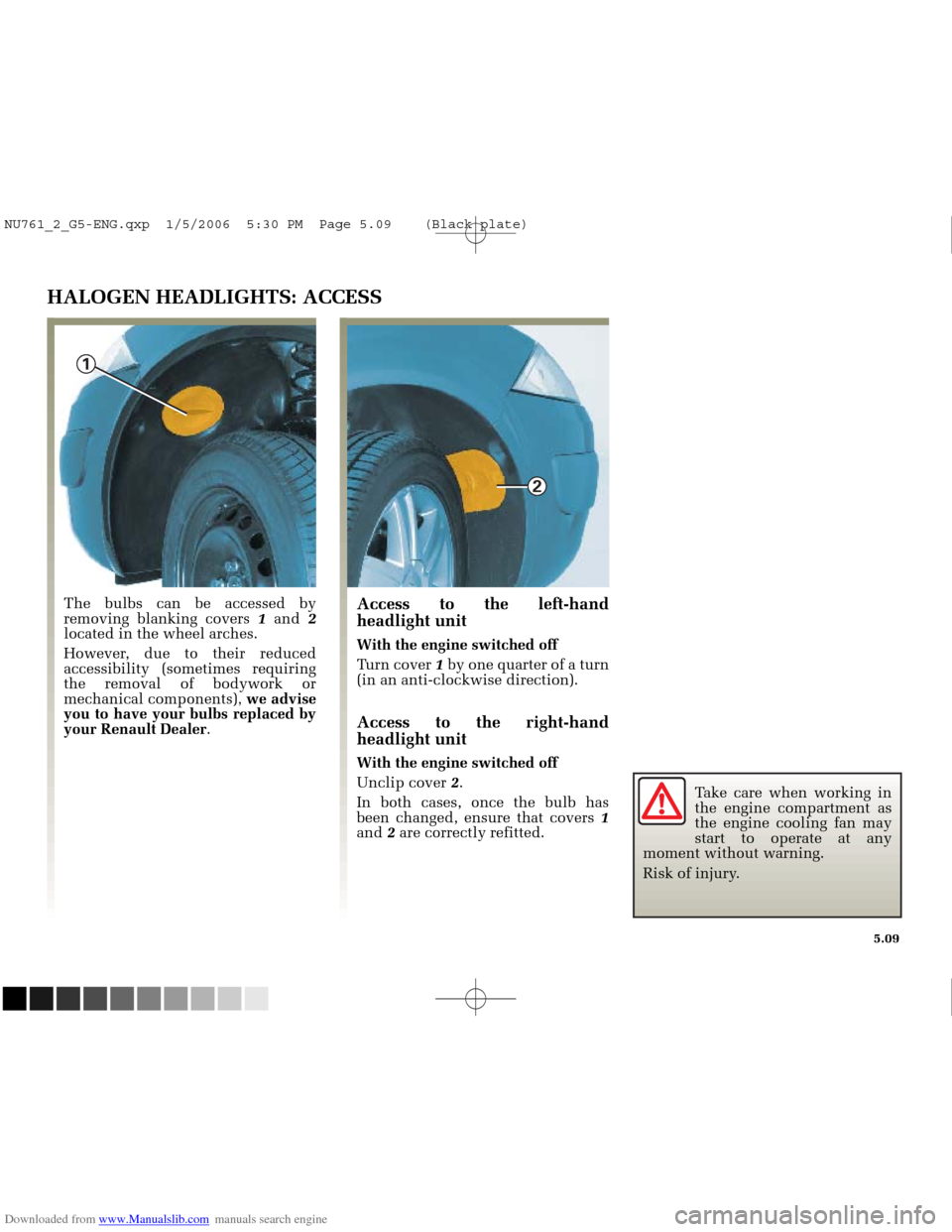
Downloaded from www.Manualslib.com manuals search engine
2
1
NU761_2_G5-FRA.qxd 4/11/05 11:09 Page 5.09
5.09
HALOGEN HEADLIGHTS: ACCESS
Access to the left-hand
headlight unit
With the engine switched off
Turn cover 1by one quarter of a turn
(in an anti-clockwise direction).
Access to the right-hand
headlight unit
With the engine switched off
Unclip cover 2.
In both cases, once the bulb has
been changed, ensure that covers 1
and 2 are correctly refitted.
The bulbs can be accessed by
removing blanking covers
1and 2
located in the wheel arches.
However, due to their reduced
accessibility (sometimes requiring
the removal of bodywork or
mechanical components), we advise
you to have your bulbs replaced by
your Renault Dealer .
Take care when working in
the engine compartment as
the engine cooling fan may
start to operate at any
moment without warning.
Risk of injury.
NU761_2_G5-ENG.qxp 1/5/2006 5:30 PM Page 5.09 (Black plate)
Page 198 of 250
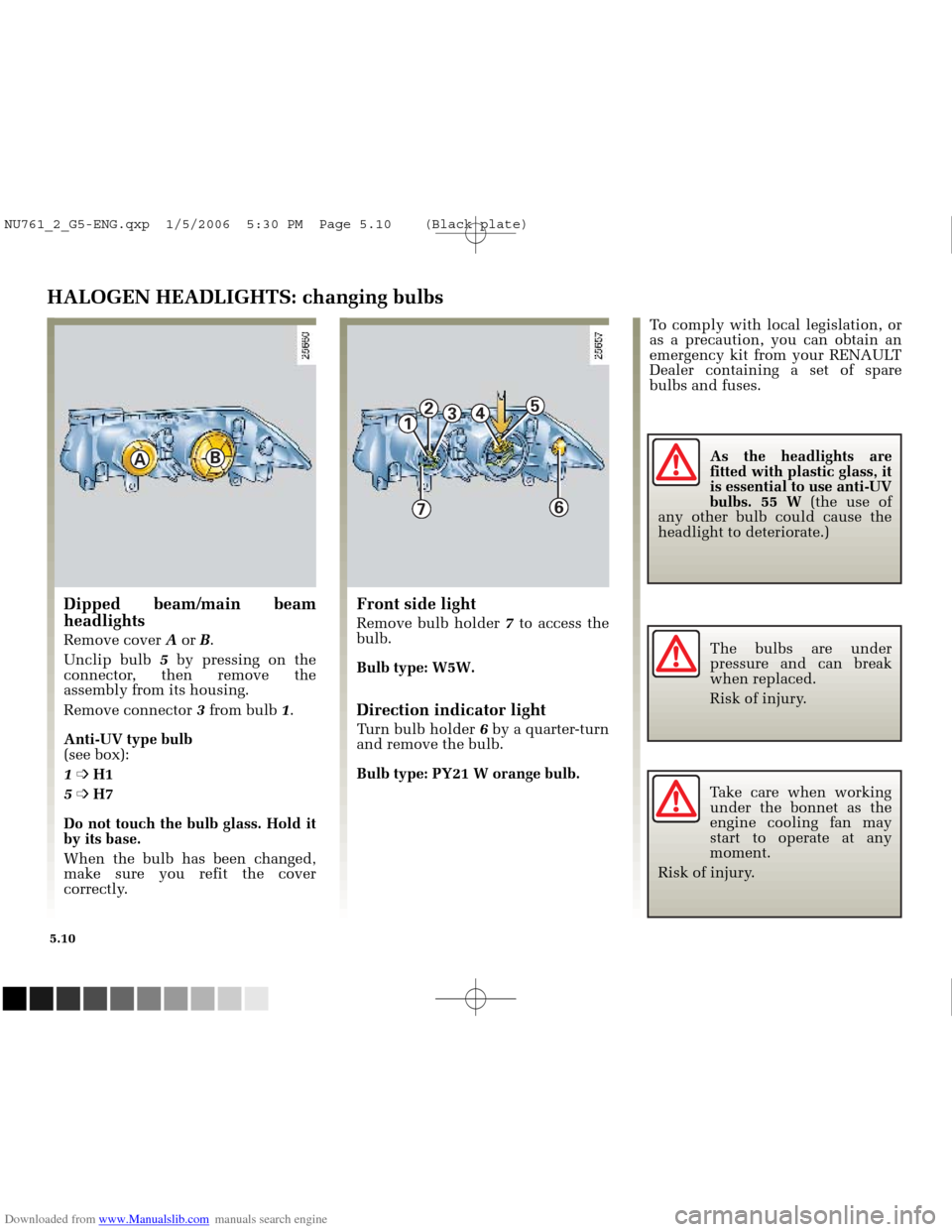
Downloaded from www.Manualslib.com manuals search engine
A
B
2
7
4
1
5
6
3
NU761_2_G5-FRA.qxd 4/11/05 11:09 Page 5.10
5.10
HALOGEN HEADLIGHTS: changing bulbs
Front side light
Remove bulb holder 7to access the
bulb.
Bulb type: W5W.
Direction indicator light
Turn bulb holder 6by a quarter-turn
and remove the bulb.
Bulb type: PY21 W orange bulb.
Dipped beam/main beam
headlights
Remove cover Aor B.
Unclip bulb 5by pressing on the
connector, then remove the
assembly from its housing.
Remove connector 3 from bulb 1.
Anti-UV type bulb
(see box):
1 ➩ H1
5 ➩ H7
Do not touch the bulb glass. Hold it
by its base.
When the bulb has been changed,
make sure you refit the cover
correctly. To comply with local legislation, or
as a precaution, you can obtain an
emergency kit from your RENAULT
Dealer containing a set of spare
bulbs and fuses.
As the headlights are
fitted with plastic glass, it
is essential to use anti-UV
bulbs. 55 W (the use of
any other bulb could cause the
headlight to deteriorate.)
The bulbs are under
pressure and can break
when replaced.
Risk of injury.
Take care when working under the bonnet as the
engine cooling fan may
start to operate at any
moment.
Risk of injury.
NU761_2_G5-ENG.qxp 1/5/2006 5:30 PM Page 5.10 (Black plate)
Page 199 of 250
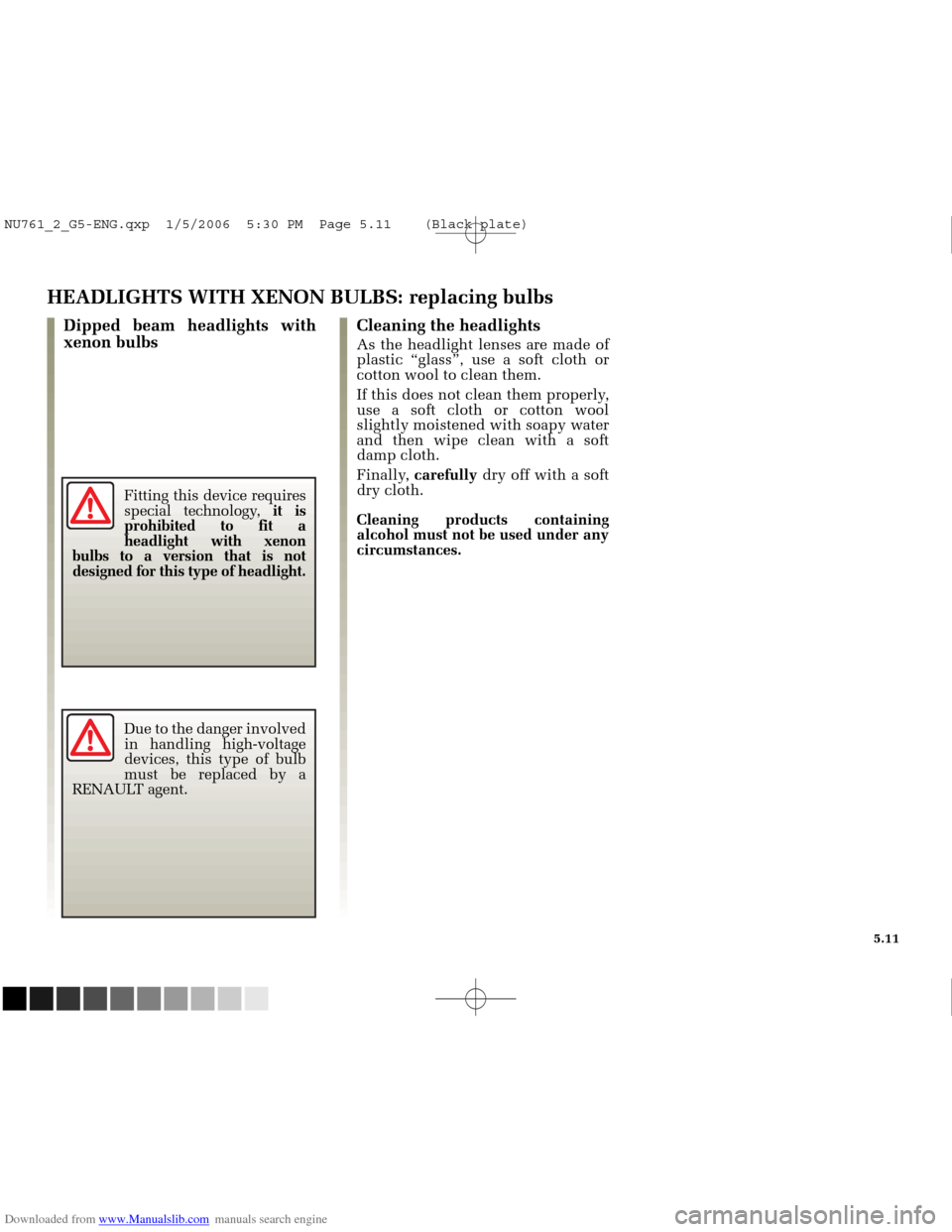
Downloaded from www.Manualslib.com manuals search engine
NU761_2_G5-FRA.qxd 4/11/05 11:09 Page 5.11
5.11
HEADLIGHTS WITH XENON BULBS: replacing bulbs
Cleaning the headlights
As the headlight lenses are made of
plastic “glass”, use a soft cloth or
cotton wool to clean them.
If this does not clean them properly,
use a soft cloth or cotton wool
slightly moistened with soapy water
and then wipe clean with a soft
damp cloth.
Finally, carefully dry off with a soft
dry cloth.
Cleaning products containing
alcohol must not be used under any
circumstances.
Dipped beam headlights with
xenon bulbs
Fitting this device requires
special technology, it is
prohibited to fit a
headlight with xenon
bulbs to a version that is not
designed for this type of headlight.
Due to the danger involved
in handling high-voltage
devices, this type of bulb
must be replaced by a
RENAULT agent.
NU761_2_G5-ENG.qxp 1/5/2006 5:30 PM Page 5.11 (Black plate)
Page 200 of 250
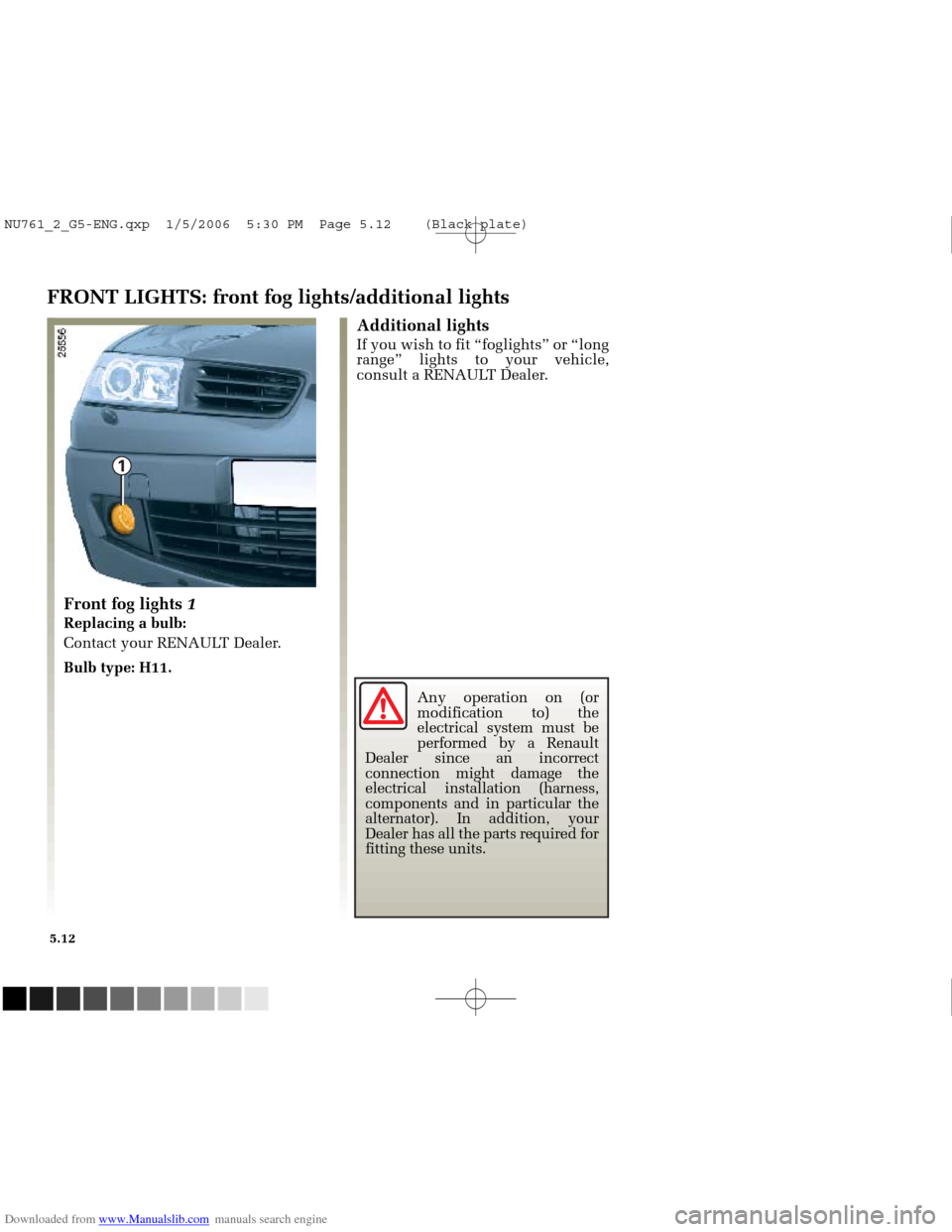
Downloaded from www.Manualslib.com manuals search engine
1
NU761_2_G5-FRA.qxd 4/11/05 11:09 Page 5.12
5.12
FRONT LIGHTS: front fog lights/additional lights
Additional lights
If you wish to fit “foglights” or “long
range” lights to your vehicle,
consult a RENAULT Dealer.
Front fog lights 1
Replacing a bulb:
Contact your RENAULT Dealer.
Bulb type: H11.
Any operation on (or
modification to) the
electrical system must be
performed by a Renault
Dealer since an incorrect
connection might damage the
electrical installation (harness,
components and in particular the
alternator). In addition, your
Dealer has all the parts required for
fitting these units.
NU761_2_G5-ENG.qxp 1/5/2006 5:30 PM Page 5.12 (Black plate)